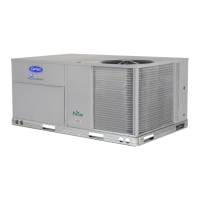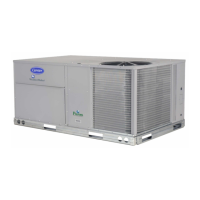129
MAJOR SYSTEM COMPONENTS
General
The 48/50P Series package rooftop units with electric cooling
and with gas heating (48P units) or electric cooling and electric
or hydronic heating (50P units) contain the ComfortLink elec-
tronic control system that monitors all operations of the roof-
top. The control system is composed of several components as
listed below. See Fig. 19-26 for typical control and power com-
ponent schematics. Figures 27-29 show the layout of the con-
trol box.
Factory-Installed Components
MAIN BASE BOARD (MBB)
See Fig 30. The MBB is the center of the ComfortLink control
system. The MBB contains the major portion of the operating
software and controls the operation of the unit. The MBB has
22 inputs and 11 outputs. See Table 105 for the inputs and out-
put assignments. The MBB also continuously monitors addi-
tional data from the EXB, RXB, SCB, and CEM boards
through the LEN communications port. The MBB also com-
municates with and controls the actuator motors, economizer,
power exhaust dampers, VFDs, IGVs, hydronic valves, and hu-
midifier valves. The MBB also interfaces with the Carrier
Comfort Network
®
system through the CCN communications
port located on the COMM3 board. The COMM3 board has
permanent terminals as well as a J11 jack for temporary con-
nections. The board is located in the main control box.
ROOFTOP CONTROL BOARD (RXB)
The RXB has additional inputs and outputs required for the
control of the unit. All units have an RXB board. See Fig. 31.
The board has 9 inputs and 8 outputs. Details can be found in
Table 106. The RXB board is located in the main control box.
ECONOMIZER CONTROL BOARD (EXB)
The EXB is used on size 075-100 units with optional return
fan, optional digital scroll compressor, or accessory humidifier.
See Fig. 31. The board has inputs to sense the return fan cfm
and supply fan cfm. This board is located in the main control
box. Input and output assignments are summarized in
Table 107.
STAGED GAS HEAT BOARD (SCB)
When optional staged or modulating gas heat is used, the SCB
board is installed and controls additional stages of gas heat.
See Fig. 32. The SCB also provides additional sensors for
monitoring of the supply-air and limit switch temperatures. For
units equipped with modulating gas heat, the SCB provides the
4 to 20 mA signal to the SC30 board that sets the modulating
gas section capacity. This board is located in the main unit con-
trol box. The inputs and outputs are summarized in Table 108.
CONTROL EXPANSION MODULE (CEM)
The optional CEM is used to provide inputs for demand limiting,
remote set point, and other optional inputs typically needed for en-
ergy management systems. See Fig. 33. On CCN systems, these
inputs can be interfaced through the CCN communications. It is
located in the main control box. The CEM has inputs for accesso-
ry relative humidity sensors. This board is also used on units
equipped with optional outdoor air CFM monitoring. The inputs
and outputs are summarized in Table 109.
The optional (or accessory) CEM is used to accept inputs for
additional sensors or control sequence switches, including:
• Smoke control mode field switches
• VAV supply air set point reset using an external 4 to 20 mA
signal
• Outdoor air CO
2
sensor
• Space, return and/or outdoor air relative humidity sensors
• IAQ function discrete switch
• Demand limit sequence proportional signals or discrete
switches
The CEM is factory-installed when the outdoor air cfm control
option is installed.
COMPRESSOR EXPANSION BOARD (CXB)
The CXB is used on size 090 and 100 units only to provide ad-
ditional compressor outputs and CSB inputs. See Table 110.
EXPANSION VALVE CONTROL BOARD (EXV)
The EXV is used on Humidi-MiZer
®
equipped units only. It is
used to provide control of the condenser and bypass modulat-
ing valves. See Table 111.
LOW VOLTAGE TERMINAL STRIP
This circuit board provides a connection point between the ma-
jor control boards and a majority of the field-installed accesso-
ries. See Table 112. The circuit breakers for the low voltage con-
trol transformers, interface connection for the Carrier Comfort
Network
®
(CCN) communication, and interface connection for
the Local Equipment Network (LEN) communication are also
located on the low voltage terminal strip.
INTEGRATED GAS CONTROL (IGC)
One IGC is provided with each bank of gas heat exchangers.
One is used on low heat size 030-050 units. Two are used on
high heat size 030-050 units and low heat 055-100 units. Three
are used on high heat 055-100 units. The IGC controls the di-
rect spark ignition system and monitors the rollout switch, lim-
it switches, and induced-draft motor Hall Effect switch.
For units equipped with Modulating Gas heat, the IGC in the
Modulating Gas section uses a Pressure Switch in place of the
Hall Effect sensor. The IGC is equipped with a LED (light-
emitting diode) for diagnostics. See Table 113.
CURRENT SENSOR BOARD (CSB)
This board monitors the status of the compressor by sensing
the current flow to the compressors and then providing digital
status signal to the MBB and CXB.
TIMER RELAY CONTROL BOARD (TR1)
The TR1 is used on modulating gas heat equipped units only. It
is located in the Gas Heat section and is used in combination
with the SC30 to provide control of the Modulating Gas Heat
section. The TR1 receives an input from the IGC, initiates a
start-up sequence, powers the SC30, sets the induced-draft mo-
tor speed, and provides the main gas valve high fire input.
When the startup sequence is complete, the TR1 checks the in-
put from the SC30 to determine which state to command the
induced-draft motor and main gas valve. See Table 114.
SIGNAL CONDITIONER CONTROL BOARD (SC30)
The SC30 is used on modulating gas heat equipped units only.
It is located in the Gas Heat section and is used in combination
with the TR1 to provide control of the Modulating Gas Heat
section. The SC30 is powered by an output from the TR1. It re-
ceives a capacity input from the SCB, provides a capacity out-
put to the modulating gas valve, and provides an output to the
TR1 to determine which state to command the induced-draft
motor and main gas valve. See Table 115.

